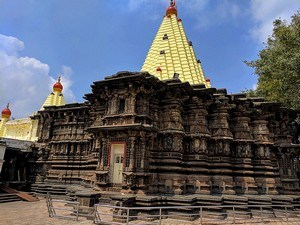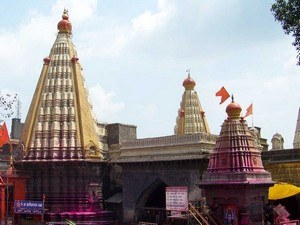Sri Mahalakshmi Temple, Kolhapur - Timings, Festivals, History, Darshan, Pooja Timings
Photo Credit: Flickr
 India | Maharashtra | Kolhapur
India | Maharashtra | Kolhapur
 #1 of 29 Places to Visit in Kolhapur
#1 of 29 Places to Visit in Kolhapur
 Distance (From Kolhapur): 2.5 Kms
Distance (From Kolhapur): 2.5 Kms
 Trip Duration (Including Travel): 1-2 Hours
Trip Duration (Including Travel): 1-2 Hours
 Transportation Options: Cab / Auto
Transportation Options: Cab / Auto
 Travel Tips: None
Travel Tips: None
About Sri Mahalakshmi Temple
At a distance of 2.5 Km from Kolhapur Railway Station, Sri Mahalakshmi Temple is a prominent Hindu temple situated in the city of Kolhapur, Maharashtra. The temple is dedicated to the goddess of wealth, Sri Mahalakshmi, also known as Goddess Ambabai, the guardian deity of Kolhapur who killed demon Kolhasura. It is one of the popular places of pilgrimage in India, and among the must include places in Kolhapur tour packages. Sri Mahalakshmi Temple, often referred to as Dakshin Kashi, is recognized as one of the six sacred sites dedicated to 'Shakti' (the Goddess of Power), where devotees can seek the fulfillment of their desires and attain salvation. The Ambabai Temple of Kolhapur in Maharashtra is one of the three and half Shakti Peethas listed in various puranas of Hinduism.
History of Sri Mahalakshmi Temple
Sri Mahalakshmi Temple in Kolhapur was established in the 7th century by the Chalukya monarch Karandev. Over the years, the temple received royal patronage from several royal families, including the Chalukyas, Rashtrakutas, Shilaharas, and Yadavas. In the 11th century CE, King Gandaraditya of the Shilahara dynasty constructed the circumambulation path and two sanctum sanctorums dedicated to Goddess Mahakali and Mahasaraswati.
Between 1178 and 1209, during the reign of Raja Jaysing and Sindhava, the South Gate and Atibaleshwar Temple were erected. In 1218, Yadav king Tolum built the Mahadwar and presented jewels to the goddess. During the Mughal era, the idol of the goddess was concealed in the residence of a priest for safekeeping. It was restored to the temple on Vijayadashami in 1712, during Sambhaji's reign. The Garuda Mandap was added by Daji Pandit between 1838 and 1843. As the number of devotees increased, the goddess's idol began to wear down due to frequent Abhishekas. Consequently, Sankeshwar Shankaracharya oversaw its restoration, and it was reinstalled by Kolhapur Shahajee Raje in 1954. The temple underwent further expansion in 1960 under the guidance of Mr. Lohiya.
Mythology of Sri Mahalakshmi Temple
The legend associated with the Mahalaxmi Temple in Kolhapur revolves around the goddess Mahalakshmi, who is said to have defeated the demon Kolhasur, which is how the city acquired its name. Additionally, it is recognized as one of the 51 Shakti Peethas, where fragments of Goddess Sati's body are believed to have fallen following her self-immolation. According to the myth, Kolhasur was a menacing demon who plagued the area, prompting the local populace to seek the protection of Goddess Mahalakshmi, also referred to as Ambabai. The goddess engaged in battle with the demon and ultimately subdued him. In his final moments, Kolhasur requested that the city bear his name, leading to the establishment of Kolhapur.
Architecture of Sri Mahalakshmi Temple
The Kolhapur Mahalakshmi Temple is an excellent example of the Hemandpanthi architectural style. The walls of the temple complex are decorated with beautiful carvings and numerous sculptures. The temple complex also comprises five towers and a chief hall. Mounted on a stone platform, the idol of the crowned goddess is made of black sandstone and weighs about 40 kilograms. The 3 feet idol of Mahalaxmi is in standing posture with four hands holding a matulinga (a citrus fruit) in the upper right, a large mace in the upper left, a shield in the lower right, and a bowl in the lower left. The idol is elegantly adorned with diamonds and precious stones. A stone lion, the vehicle of the goddess, stands behind the statue.
Unlike most Hindu sacred images, which face north or east, the image of this deity looks west (Pashchim). Another unique feature of this temple is that every year from November 9-12 and January 31st to February 3rd, the sun's rays fall upon the idol of Maa Ambabaithrough a window in the temple.This event is celebrated as a festival known as Kiranotsav.
On the left side of the main shrine is the temple of Mahasaraswati and on the right is the Mahakali temple. The Shri Yantra is carved on one of the corners opposite Mahakali Temple in the temple premises. There are several other shrines in the courtyard dedicated to Navagrahas, Surya, Mahishasuramardini, Vitthal-Rakhmai, Krishna, Swami Smarth Dashavartar, Ram Mandir, Mahavishnu, Hanuman, Laxmi-Narayan, Khandoba, Atibaleshwar, Kalbhairav, Sidhivinyak, Lord Datta, and Tulja Bhavani. The complex also has a temple tank Manikarnika Kund, near Datta Mandir.
Festivals of Sri Mahalakshmi Temple
The Navratra festival is celebrated with immense fervor over a span of ten days during the Hindu month of Ashwin, which typically falls in October. Throughout this period, the Goddess is decorated in various forms with flowers and lights, and she is paraded in procession within the temple complex. Additionally, the Rathotsav, or chariot festival, takes place in April, and the Kiranotsav occurs when the Sun god pays tribute to Mahalakshmi Ambabai for three days each year during 'Rath Saptami' in January are the other significant festivals at the Kolhapur Temple that attract large crowds and feature intricate rituals and cultural events.
Kolhapur Mahalakshmi Temple Dress Code & Other Restrictions
While the Mahalakshmi Temple in Kolhapur doesn't have a strict dress code, it is recommended to adhere to modest clothing that covers your upper arms and legs as a sign of respect. Men are encouraged to wear a dhoti or pajama paired with an upper garment, as well as formal trousers and shirts. Women may opt for a saree, half saree, or chudidhars. It is advisable to refrain from wearing contemporary attire such as mini-skirts, shorts, and sleeveless tops while on the temple grounds.
Non-Hindus are welcome to explore the temple complex and appreciate its architectural beauty; however, access to the sanctum sanctorum may be restricted.
Sri Mahalakshmi Temple Timings
Monday: 5 AM - 10 PM, Aarti: 5:30 AM, 6:30 PM, 8 PM & 10 PM
Tuesday: 5 AM - 10 PM, Aarti: 5:30 AM, 6:30 PM, 8 PM & 10 PM
Wednesday: 5 AM - 10 PM, Aarti: 5:30 AM, 6:30 PM, 8 PM & 10 PM
Thursday: 5 AM - 10 PM, Aarti: 5:30 AM, 6:30 PM, 8 PM & 10 PM
Friday: 5 AM - 10 PM, Aarti: 5:30 AM, 6:30 PM, 8 PM & 10 PM
Saturday: 5 AM - 10 PM, Aarti: 5:30 AM, 6:30 PM, 8 PM & 10 PM
Sunday: 5 AM - 10 PM, Aarti: 5:30 AM, 6:30 PM, 8 PM & 10 PM
Sri Mahalakshmi Temple Entry Fee
General Entry is Free
Special Darshan available for Rs. 50 & Rs. 500
Best Time to Visit Sri Mahalakshmi Temple
The period from November to February is ideal for visiting Kolhapur Mahalakshmi Temple, as the weather is particularly enjoyable during these months. Additionally, this timeframe coincides with the celebration of Navaratri, a major festival that offers visitors a unique opportunity to experience the local culture and religious traditions. However, it is important to keep in mind that the temple may be more crowded than usual during these festivities. Alternatively, one may consider visiting Kolhapur during the monsoon season, which lasts from June to September and brings moderate rainfall. It is advisable to steer clear of the summer months from March to May, as temperatures in Kolhapur can be extremely high.
How to Reach Sri Mahalakshmi Temple
Located approximately 10 kilometers from the Mahalaxmi Temple in Kolhapur, Chhatrapati Rajaram Maharaj Airport serves as the nearest airport, offering flight connections to major cities such as Hyderabad, Bengaluru, and Mumbai. The closest international airports to Kolhapur are Pune International Airport, situated 243 kilometers away, and Goa International Airport, which is 246 kilometers distant. Kolhapur Railway Station provides direct train services from various cities, including Mumbai, Pune, Delhi, Tirupati, Hyderabad, Ahmedabad, Nagpur, Bangalore, Gorakhpur, Satara, Sangli, Solapur, Dhanbad, Bidar, and Mangalore. Additionally, Kolhapur is conveniently located on NH-4, ensuring robust bus connectivity to Mumbai, Bangalore, Pune, Belgaum, Solapur, Sangli, Panjim, Satara, Mahabaleshwar, Nashik, Hyderabad, and Hubli. Visitors can access the temple by utilizing city buses or by hiring a cab or auto-rickshaw from any area within Kolhapur.

















